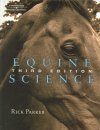About this book
Equine Science, third edition was designed to make teaching and learning easy. Based on a thorough, easy-to-follow outline that makes developing a lesson plan simple, each chapter starts with a list of learning objectives that helps the student identify the most important concepts in the chapter. Throughout the book, tables, charts, graphs and illustrations provide easy access to information without wading through excess detail, enabling students to quickly grasp the content. To help maintain interest, each chapter contains at least one sidebar to encourage retention of the information learned, and the discussion of new topics. In the student activities section at the end of each chapter, students and instructors will find opportunities for learning by applying the knowledge they have gained from the book. The appendix contains helpful tables with information for converting units of measure, and for making contact with the industry and organizations as well as web addresses for equine industries and other useful Internet sites.
New to this edition:
- Updated full color photos, tables and graphs throughout to enhance learning.
- Updated URLs in the book and the appendix
- New section on soft skills appear in chapter on careers
Contents
Preface
Chapter 1: History and Development of the Horse
Chapter 2: Status and Future of the Horse Industry
Chapter 3: Breeds, Types and Classes of Horses
Chapter 4: Cells, Tissues, and Organs
Chapter 5: Functional Anatomy
Chapter 6: Biomechanics of Movement
Chapter 7: Unsoundness
Chapter 8: Selecting and Judging Horses
Chapter 9: Determining Age, Height, and Weight of Horses
Chapter 10: Genetics
Chapter 11: Reproduction and Breeding
Chapter 12: Digestion and Nutrition
Chapter 13: Feeds and Feeding Horses
Chapter 14: Health Management
Chapter 15: Parasite Control
Chapter 16: Common Management Practices
Chapter 17: Shoeing and Hoof Care
Chapter 18: Buildings and Equipment
Chapter 19: Horse Behavior and Training
Chapter 20: Equitation
Chapter 21: Business Aspects
Chapter 22: Career Opportunities
Glossary
Appendix
Customer Reviews
Biography
Dr. Parker is the director for AgrowKnowledge, the National Center for Agriscience and Technology Education, a project funded by the National Science Foundation. The former division director at the College of Southern Idaho, he worked in agriculture, information technology, drafting, and electronics, and taught computer, agriculture, and writing classes. He is the 2008 recipient of the NACTA (National American Colleges and Teachers of Agriculture) Distinguished Educator Award, and the 2010 recipient of the NACTA Murray Brown Leadership Award. Dr. Parker has authored several textbooks ("Plant & Soil Science", "
Aquaculture Science" (Third Edition), "
Introduction to Plant Science", "Introduction to Food Science", and others), and serves as Editor of the NACTA Journal. He earned his undergraduate degree from Brigham Young University, a Ph.D. in Reproductive Physiology from Iowa State University, and completed post-doctoral work at the University of Alberta, Edmonton, and the University of Wyoming, Laramie.























